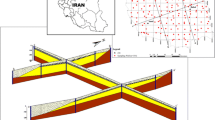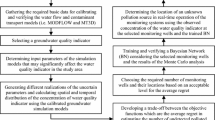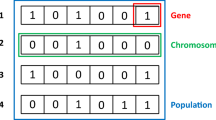Abstract
In the process of identifying groundwater pollution sources, in order to solve the problem that the monitoring data of monitoring wells was insufficient or the correlation between monitoring data and model parameters was weak, a monitoring well optimization method based on Bayesian formula and information entropy was proposed. Two-dimensional phreatic groundwater solute transport model was built and solved by using GMS software. To reduce the computational load of calling the numerical model repeatedly in the optimization design of the monitoring schemes and the identification process of the pollution sources, the Kriging method was used to establish the surrogate model of the numerical model. Under the condition of single well monitoring and determined monitoring frequency, with the target of optimization of monitoring position number D and monitoring time interval ∆t, both the single-objective monitoring scheme with the minimum information entropy of the model parameter posterior distribution and the multi-objective monitoring scheme with the minimum information entropy and the shortest monitoring time were optimized respectively. According to the above-optimized monitoring schemes, the delayed rejection adaptive Metropolis algorithm was used to identify the pollution source parameters. The case study results showed that under the condition of pre-set single well monitoring with monitoring frequency of 10 times, the single-objective optimized monitoring scheme was D = 37 and Δt = 20 days. Under this monitoring scheme, the mean errors of inversion pollution source parameters α = (XS, YS, T1, T2, QS) were 0.09%, 0.4%, 4.72%, 2.43%, and 9.29%, respectively. The multi-objective optimized monitoring scheme was D = 37 and Δt = 2 days. Under this monitoring scheme, the mean errors of the inversion parameters α = (XS, YS, T1, T2, QS) were 12.76%, 3.77%, 5.13%, 1.36%, and 7.68%, respectively. Compared with the monitoring scheme based on the single-objective optimization, although the inversion mean error of the five parameters based on the multi-objective optimized monitoring scheme increased by 2.75%, the monitoring time significantly reduced from 180 to 18 days.







Similar content being viewed by others
Explore related subjects
Discover the latest articles and news from researchers in related subjects, suggested using machine learning.References
Carrera, J., & Neuman, S. P. (1986). Estimation of aquifer parameters under transient and steady state conditions: 2. Uniqueness, stability, and solution algorithms. Water Resour Res, 22(2), 211–227. https://doi.org/10.1029/wr022i002p00211.
Chen, M., Izady, A., Abdalla, O. A., & Amerjeed, M. (2018). A surrogate-based sensitivity quantication and Bayesian inversion of a regional groundwater fow model. J Hydrol, 557, 826–837. https://doi.org/10.1016/j.jhydrol.2017.12.071.
Deb, K., Pratap, A., Agarwal, S., & Meyarivant, T. (2002). A fast and elitist multiobjective genetic algorithm: NSGA-II. IEEE Trans Evol Comput, 6(2), 182–197. https://doi.org/10.1109/4235.996017.
Dougherty, D. E., & Marryott, R. A. (1991). Optimal groundwater management: 1. Simulated annealing. Water Resour Res, 27(10), 2493–2508. https://doi.org/10.1029/91wr01468.
Gabriela, C., Sarma, S. V., Eden, U. T., & Brown, E. N. (2008). A signal-to-noise ratio estimator for generalized linear model systems. Lect Notes Eng Computer Sci, 2171(1), 1063–1069 http://www.iaeng.org/publication/WCE2008/WCE2008_pp1063-1069.pdf.
Gao. Y. (2008). Optimization methods based on Kriging surrogate model and their application in injection molding. Dalian: Dalian University of Technology.
Gelman, A. G., & Rubin, D. B. (1992). Inference from iterative simulation using multiple sequences. Stat Sci, 7, 457–472. https://doi.org/10.1214/ss/1177011136.
Giacobbo, F., Marseguerra, M., & Zio, E. (2002). Solving the inverse problem of parameter estimation by genetic algorithms: the case of a groundwater contaminant transport model. Ann Nucl Energy, 29(8), 967–981. https://doi.org/10.1016/S0306-4549(01)00084-6.
Haario, H., Saksman, E., & Tamminent, J. (2001). An adaptive Metropolis algorithm. Bernoulli, 7(2), 223–242. https://doi.org/10.2307/3318737.
Haario, H., Laine, M., & Mira, A. (2006). DRAM: efficient adaptive MCMC. Stat Comput, 16(4), 339–354. https://doi.org/10.1007/s11222-006-9438-0.
Hastings, W. K. (1970). Monte Carlo sampling methods using Markov chains and their applications. Biometrika, 57(1), 97–109. https://doi.org/10.2307/2334940.
Hickernell, F. A. (1998). A generalized discrepancy and quadrature error bound. Math Comput, 67(221), 299–322. https://doi.org/10.2307/2584985.
Huan, X., & Marzouk, Y. M. (2013). Simulation-based optimal Bayesian experimental design for nonlinear systems. J Comput Phys, 232(1), 288–317. https://doi.org/10.1016/j.jcp.2012.08.013.
Knill, D. L., Giunta, A. A., Baker, C. A., Grossman, B., Mason, W., Haftka, R., & Watson, L. T. (1999). Response surface models combining linear and Euler aerodynamics for supersonic transport design. J Aircr, 36(1), 75–86. https://doi.org/10.2514/2.2415.
Kuhnt, S., & Steinberg, D. M. (2010). Design and analysis of computer experiments. AStA AdvStat Anal, 94(4), 307–309. https://doi.org/10.1007/s10182-010-0143-0.
Lenhart, L., Eckhardt, K., Fohrer, N., & Frede, H. G. (2002). Comparison of two different approaches of sensitivity analysis. Phys Chem Earth, 27, 645–654. https://doi.org/10.1016/S1474-7065(02)00049-9.
Lindley, D. V. (1956). On a measure of the information provided by an experiment. Ann Math Stat, 27(4), 986–1005. https://doi.org/10.1214/aoms/1177728069.
Lophaven, S. N., Nielsen, H. B., & Sondergaard, J. (2002). Dace: a MATLAB Kriging toolbox. Kongens Lyngby, Technical University of Denmark: Technical Report No. IMM-TR-2002-12.
Luo, J., Ji, Y., & Lu, W. (2019). Comparison of surrogate models based on different sampling methods for groundwater remediation. J Water Resour Plan Manag, 145(5), 04019015. https://doi.org/10.1061/(ASCE)WR.1943-5452.0001062.
Metropolis, N., Rosenbluth, A. W., Rosenbluth, M. N., & Teller, A. H. (1953). Equation of state calculations by fast computing machines. J Chem Phys, 21(6), 1087–1092. https://doi.org/10.1063/1.1699114.
Mira, A. (2002). Ordering and improving the performance of Monte Carlo Markov chains. Stat Sci, 16, 340–350. https://doi.org/10.1214/ss/1015346319.
Roberts, C. P., & Casella, G. (2004). Monte Carlo statistical methods (second edition). Springer https://doi.org/10.1007/978-1-4757-4145-2.
Ruzek, B., & Kvasnicka, M. (2001). Differential evolution algorithm in the earthquake hypocenter location. Pure Appl Geophys, 158, 667–693. https://doi.org/10.1007/PL00001199.
Shannon, C. E. (1948). A mathematical theory of communication. Bell Syst Tech J, 27(3), 379–423. https://doi.org/10.1002/j.1538-7305.1948.tb00917.x.
Snodgrass, M. F., & Kitanidis, P. K. (1997). A geostatistical approach to contaminant source identification. Water Resour Res, 33(4), 537–546. https://doi.org/10.1029/96WR03753.
Sohn, M. D., Small, M. J., & Pantazidou, M. (2000). Reducing uncertainty in site characterization using Bayes Monte Carlo methods. J Environ Eng-ASCE, 126(10), 893–902. https://doi.org/10.1061/(ASCE)0733-9372(2000)126:10(893).
Tierney, L., & Mira, A. (1999). Some adaptive Monte Carlo methods for bayesian inference. Stat Med, 18, 2507–2515. https://doi.org/10.1002/(sici)1097-0258(19990915/30)18:17/18<2507::aid-sim272>3.
Wang, X., Zhang, D., & Chen, L. (2018). Real-time monitoring of pollutant diffusion states and source using fuzzy adaptive Kalman filter. Water Air Soil Pollut, 229(7), 238. https://doi.org/10.1007/s11270-018-3885-z.
Wei, G., Chi, Z., Yu, L., Liu, H., & Zhou, H. (2016). Source identification of sudden contamination based on the parameter uncertainty analysis. J Hydroinf, 18(6), 919–927. https://doi.org/10.2166/hydro.2016.002.
Zhang, J. (2017). Bayesian monitoring design and parameter inversion for groundwater contaminant source identification. Hangzhou: Zhejiang University- Thesis Doctorate.
Zhang, S., Liu, H., Qiang, J., Gao, H., Galar, D., & Lin, J. (2019). Optimization of well position and sampling frequency for groundwater monitoring and inverse identification of contamination source conditions using Bayes’ Theorem. Comput Model Eng Sci, 119(2), 373–394. https://doi.org/10.32604/cmes.2019.03825.
Author information
Authors and Affiliations
Corresponding author
Additional information
Publisher’s Note
Springer Nature remains neutral with regard to jurisdictional claims in published maps and institutional affiliations.
Rights and permissions
About this article
Cite this article
Zhang, S., Qiang, J., Liu, H. et al. Optimization Design of Groundwater Pollution Monitoring Scheme and Inverse Identification of Pollution Source Parameters Using Bayes’ Theorem. Water Air Soil Pollut 231, 27 (2020). https://doi.org/10.1007/s11270-019-4369-5
Received:
Accepted:
Published:
DOI: https://doi.org/10.1007/s11270-019-4369-5




